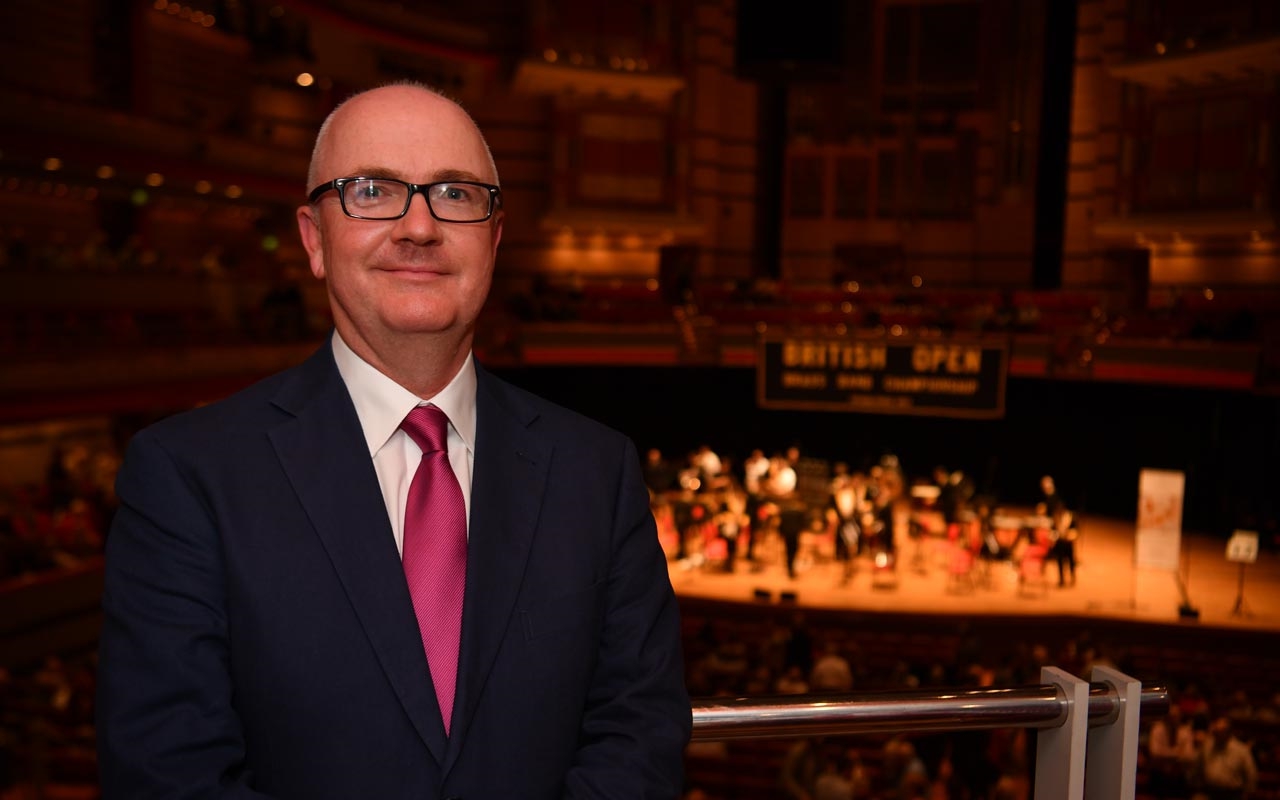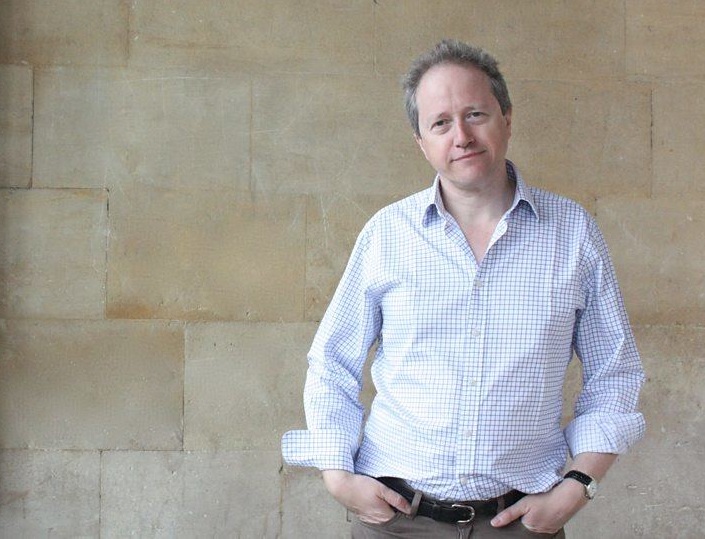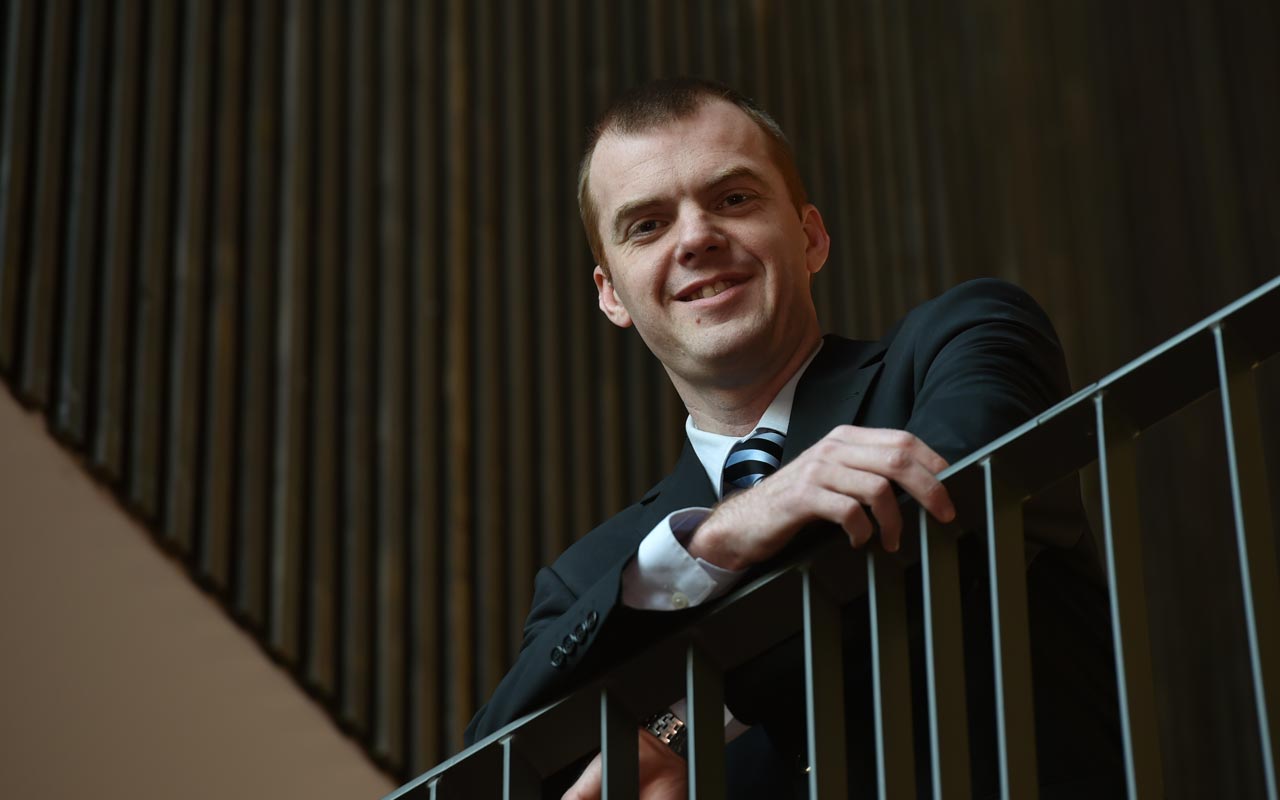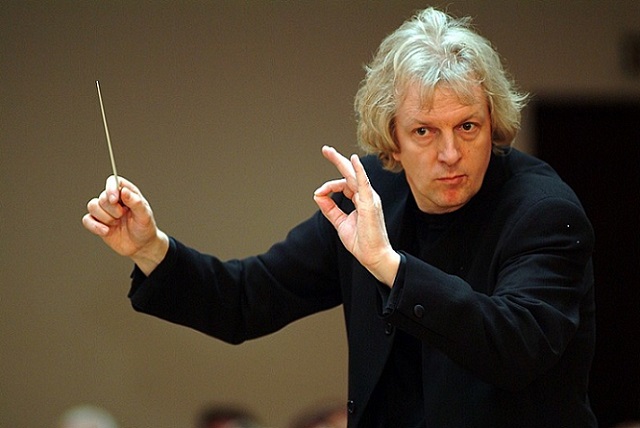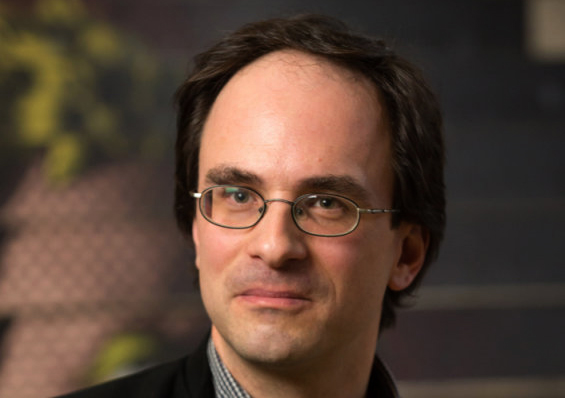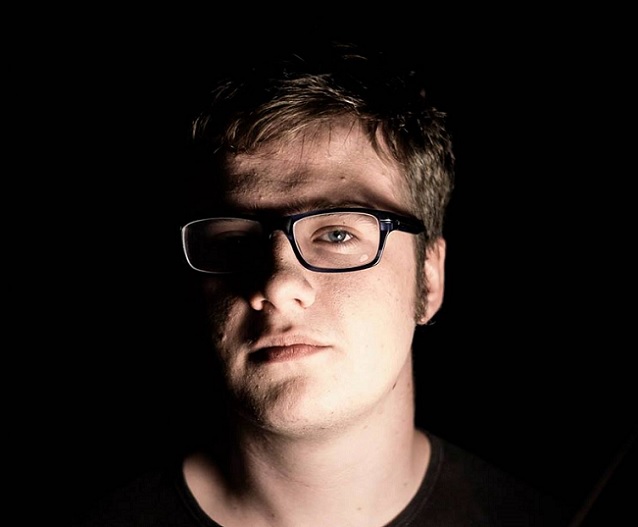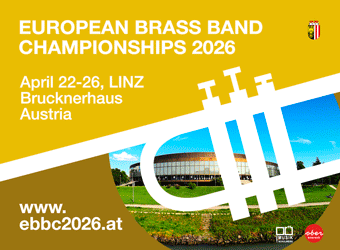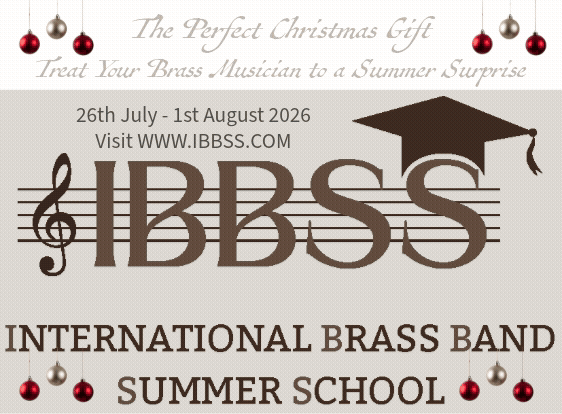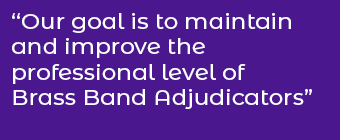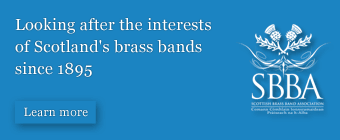
A Gabrieli Fantasy (Bert Appermont)
‘A Gabrieli Fantasy’ is an extended exploration of an original octet composition ‘Canzon in Diouble Ech a 12’ written in 1608 by Italian composer Giovani Gabrieli, with the Belgian composer Bert Appermont developing the work into five linked elements based on a triple chorus (group) band structure.
The composer adds that the three groups are both sperate and co-joined – the central group positioned sufficiently back as to act as a musical echo to the ensembles spaciously flanked each side of it.
Different kinds of triple chorus are used – from letting the triptych play in different sections in quick succession, to echoes of melodies, motifs and cell chords, extended, distorted, expanded or simply adapted in various contrapuntal or canonic variants.
Different kinds of triple chorus are used – from letting the triptych play in different sections in quick succession, to echoes of melodies, motifs and cell chords, extended, distorted, expanded or simply adapted in various contrapuntal or canonic variants.
Part 1 (‘Canzon’) is formed from the original melody but adapted quickly into the virtuosic passages, choral and tutti themes of a ‘Toccata’.
A ‘Chorale’ creates dissonance and mystery based on four tones of the original Canzon whilst the ‘Scherzo’ that follows also adapts the thematic cell but in a completely new identity – including a sarcastic canon between the three groups.
The finale returns the music to its glorious theme – hammering motifs and virtuosic scalic passages adding to the ornate colourings of neo-baroque inspiration.
The prestissimo ending adds all the elements together for a glorious climax.
Dynasty (Peter Graham)
Peter Graham’s ‘symphonic poem’ was originally written for the 2019 British Open Championships and is inspired by the musical life of the legendary Harry Mortimer.
The composer describes it as something of ‘a musical adventure story’ – and takes its ‘dynastic’ linear development from Mortimer’s own recollections.
It is a deliberately romanticised story of a player destined from birth to be the ‘best cornet player in England’ – initially driven by his father through to his first major contest experience at Crystal Palace in 1913.
It is a deliberately romanticised story of a player destined from birth to be the ‘best cornet player in England’ – initially driven by his father through to his first major contest experience at Crystal Palace in 1913.
Fred’s own war time experience is recalled, which contrasts with Harry’s own development in theatres and musical hall orchestras and ensembles.
New challenges come as joined by brothers Rex and Alex under their father’s baton they become the stanchion points of the great Foden’s Band of the 1930s, before the baton is passed to Harry on his father’s death.
His playing and conducting successes are recalled through direct and indirect quotation – from ‘Sovereign Heritage’ to ‘Messiah’ with the work ending in a dramatic fugue that closes in a triumphant affirmation of a life of musical glory and achievement.
Eden (John Pickard)
‘Eden’ was commissioned for the final of the 2005 National Championships of Great Britain and is prefaced by the lines of John Milton's, ‘Paradise Lost' written in 1663.
"The world was all before them, where to choose
Their place of rest, and providence their guide:
They hand in hand with wandering steps and slow,
Through Eden took their solitary way."
Like Milton, Pickard develops the works as a metaphor for man’s relationship with his creator and his ultimate nihilistic tendencies to reject it in favour of earthly pleasures.
The three linked sections provide a powerful template; the first exploring the figures of Adman, Eve and the questioning evil of the serpent (played by the trombone) in destroying innocence – a decision that irrevocably lead to man’s ultimate destruction.
Like Milton, Pickard develops the works as a metaphor for man’s relationship with his creator and his ultimate nihilistic tendencies to reject it in favour of earthly pleasures.
That ‘havoc’ as the composer calls it, is explored in the central section that evokes the rapacious greed and exploitation of nature’s resources – digging out ‘ribs of gold’ from a ‘spacious wound’.
However, the final section deals with restoration and optimism, of rebirth and recreation that out of near destruction a new rebirth of hope can begin.
The composer’s use of sound and texture evokes different emotions – literal as well as symbolic, irrational to the calculating, nervous to the glorious; its darkness and jazz inflections balanced by a final section that is an intense lament that finally emerges into glorious abundance – inspired by the Eden project in Cornwall opened in 2001.
Fraternity (Thierry Deleruyelle)
Thierry Deleruyelle’s work was originally commissioned as the set-test for the 2016 European Championship in Lille and was received with widespread critical acclaim.
It is inspired by the tragic circumstances of a 1906 mining disaster in Douai in France that claimed over 1,000 lives, and is written in an open, richly tonal fashion - eschewing high-energy injections of volume and speed for more considered pacing and texture, subtly scored balances and lengthened lyrical lines.
The musical narrative, with nods of appreciation to the likes of composer Paul Dukas sets the scene. It tells the tale in linear fashion in seven linked sections; from the ‘Black Land’ and ‘Towering Colliery’ above ground, to the journey to the face to extract the coal.
The musical narrative, with nods of appreciation to the likes of composer Paul Dukas sets the scene. It tells the tale in linear fashion in seven linked sections; from the ‘Black Land’ and ‘Towering Colliery’ above ground, to the journey to the face to extract the coal.
The catastrophe is ignited by a fractured, frenzied forcefulness, the prelude to which is the ghostly on-rush of air through instruments - life or death a matter of luck.
The aftermath sees the solemn task of bringing out the dead, which draws the music into a bleak paean of reflection, before the piece ends in uplifting fashion in the form of a 'Fraternity Prayer' that pays tribute to those lost.
From Ancient Times (Jan Van der Roost)
'From Ancient Times' is inspired by the music of the Flemish polyphonists.
There are no literal quotes, but the composer uses historical composition techniques to evoke the influences of the likes of Lassus, Desprez, Willaert, Ockeghem, Obrecht, Isaac, Dufay and de Monte, as well as the artistic inspirations the great painters, Rubens, Van Dijck, Breughel and Van Eyck.
The music develops through further senza misura cadenzas and an ethereal homage to Adolphe Sax before moving towards a grandiose finale to be played with the composer’s instruction, 'like an organ'.
The piece also goes back further in time; referencing Gregorian chant as well as an estampie medieval dance, whilst a modern twist is found in the cipher ostinato references based on the notes 'EBBA' and the first chord of the estampie-theme based on the notes of 'VLAMO' (the organising organisation who commissioned the work).
The music develops through further senza misura cadenzas and an ethereal homage to Adolphe Sax before moving towards a grandiose finale to be played with the composer’s instruction, 'like an organ'.
All this is encapsulated within a contemporary structure that places huge demands on the ensemble and soloists alike; starting mysteriously but ending in glory - from ancient to modern in one huge arc of musicality.
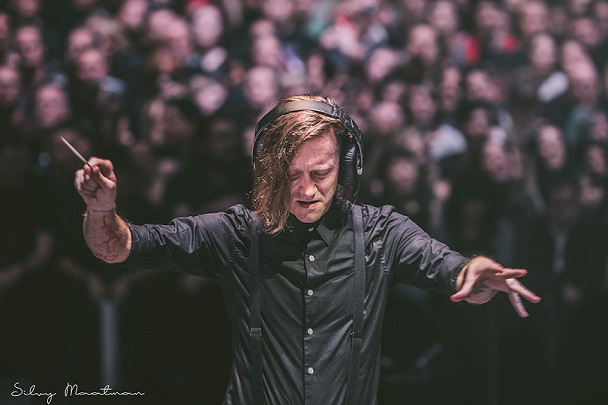
Journey of the Lone Wolf (Simon Dobson)
Simon Dobson's work is a visceral, emotive portrait of the musical, social and political life of the Hungarian composer Bela Bartok – an alienating figure greatly misunderstood during his troubled and lonely life time, much of which was spent away from his beloved homeland.
It pays homage to his early ethno-music work in the Balkans in which he recorded folk melody and song traditions that were soon to be consumed by the horrors of Nazi Germany, as well as on his troubled time in America, where his love of jazz proved to be a solitary comfort in a life of increasing isolation.
It ends with his personal ambiguities powerfully unresolved; as Bartok’s coffin is lowered into its self-willed, pitiless grave.
Poetic and passionate, it explores the psyche of a truly unique figure; an eccentric, troubling enigma to categorise and comprehend; doubtful, melancholic, proud, stubborn, cold, depressive - yet able to write music of such glorious luminosity of spirit, atmosphere and confidence.
It ends with his personal ambiguities powerfully unresolved; as Bartok’s coffin is lowered into its self-willed, pitiless grave.
No Man's Land (Thierry Deleruyelle)
This work is based on a motif inspired by the initials of World War I (WWI) (first appearing on the solo cornet) and is evoked by the composer to tell the linear focal point story of poet and writer John McCrae, who was a 42-year-old medical officer and Major of the Canadian Army.
The composition is in six linked parts: Starting with his journey from ‘Ontario - 1914’, through the horrors of the ‘Battle of Ypres’ and its ’17 Days of Hades’, to ‘Flanders Field’ which inspired his greatest poetry. ‘Bonfire’ marks McCrae’s own death. It closes with the reflection of the first ‘Poppy Day’ in 1921.
The music explores the sentiments and attitudes of the time; the passions and blunders of involvement – from McCrae’s own opportunity to write poetry and to the hellish landscape from which he had to draw inspiration – especially Ypres and its deadly gas attacks.
The music explores the sentiments and attitudes of the time; the passions and blunders of involvement – from McCrae’s own opportunity to write poetry and to the hellish landscape from which he had to draw inspiration – especially Ypres and its deadly gas attacks.
The central section draws on the poet’s deep sense of loss of the death of his ‘brother in arms’ in Flanders – and his work ‘In Flanders Field’ which symbolised the send of tragedy felt by millions of families:
“In Flanders fields the poppies blow between the crosses, row on row”
McCrea was not to find solace – dying of pneumonia and meningitis on 28th January 1918 at the Wimereux military hospital where he was buried with full military honours.
The music of the finale marks his sacrifice, and that of millions of others like him.
Other Lives (Oliver Waespi)
Waespi’s composition reflects on the intriguing theme of imaginary lives - or certain stages of a single life re-interpretated through different emotional states that morph basic musical material into something new through expression.
The opening is derived from 'Der Doppelganger', one of Franz Schubert's late songs which itself is a haunting memorial to things past and lost, familiar but inherently different.
The music accelerates to find a new shape and meaning, gradually moving further away from its original essence.
The opening is derived from 'Der Doppelganger', one of Franz Schubert's late songs which itself is a haunting memorial to things past and lost, familiar but inherently different.
The first part, 'Rage', has an intensely agitated character, whilst the ensuing 'Reflection' turns back to the initial chord progression before a series of soloistic interventions explore time and space at a slower pace.
'Redemption', is a widely spaced sound field that culminates in a short, luminous reference to another Schubert song of reflective understanding entitled, 'Ruckblick'.
‘Farewell’ sees an abstract musical transformation trigger an emotional change, as the initial, gloomy minor keyed inflections are inverted, leading to a brighter harmonic landscape.
The final 'Renewal' sees a return to the grim, tense atmosphere of the first section - although transformed into an energetic exuberance of a fulfilled life - one presenting yet another interpretation of the same musical material.
Sinfonietta No 2 - Quatre Impressions (Pierre-Antoine Savoyat)
Pierre-Antoine Savoyat pays tribute to French impressionist music of the 20th century – and the compositional giants of Claude Debussy and Maurice Ravel as well as lesser known but equally important figures such as Maurice Emmanuel or Raoul Bardac.
The work comprises four movements that evoke an impressionist view of a journey through different countries as if in a child’s dream; the cyclical themes first introduced by flugel echoing a process used by both Ravel and Debussy, notably in their string quartets.
‘Prélude à un Pays Lointain’ (Prelude to a Distant Land) is an imaginary Asian landscape of nebulous imagery and evocations before opening into clarity and resolution.
The work comprises four movements that evoke an impressionist view of a journey through different countries as if in a child’s dream; the cyclical themes first introduced by flugel echoing a process used by both Ravel and Debussy, notably in their string quartets.
‘Cortège Fabuleux' (Fabulous Procession) that follows evoked a parade of exotic animals, jugglers and magicians – drawing ever near and more intriguing – the promise of mystery and danger, joviality and fantasy ever present.
It leads into ‘Dialogue du Vent et des Montagnes’ (Dialogue of the Wind and the Mountains) which pays homage to the finale of Debussy’s ‘La Mer: Dialogue du Vent et de la Mer’ of a rising sun breaking the tempest of a blizzard over epic mountainous terrain
The work closes with ‘Feria’ (Fair) a joyful evocation of the festivals in the Basque country where Ravel was born; revelry and excess that is brought to a conclusion of Ravel inspired colour.
So Spoke Albion (Gavin Higgins)
Gavin Higgins’ composition is inspired by aspects of the life of the artist, poet, illustrator, painter and engraver William Blake (1757-1827) – destined to become a seminal figure of British cultural life, although not in his lifetime.
An enigmatic man of deep complexities and radicalism, he championed beliefs thought to be completely alien to the restrictions of his time; a Christian who attacked organised religion, a mystic who would see ‘visions’ of Angels and a writer of some of the most powerful allegorical themes.
The second section ‘Catherine’ is a lyrical evocation of his wife; tender, loving, unquestioningly loyal and supportive – a woman that was one half of one of the ‘most poignant relationships in literary history’.
The composers evokes these in three linked sections: The first, ‘Angels on Peckham Rye’ a disturbing, fearfully dislocated and anxious vision of heavenly bodies he saw in a tree – their ‘bright angelic wings bespangling every bough like stars’.
The second section ‘Catherine’ is a lyrical evocation of his wife; tender, loving, unquestioningly loyal and supportive – a woman that was one half of one of the ‘most poignant relationships in literary history’.
The finale section ‘Albion Rose’ evokes Blake’s vision of England – a giant of a man, ‘stretching out naked but open to the world’, optimistic in its political awakening, inclusivity and positivity.
The Turing Test for Brass Band and Percussion (Simon Dobson)
Alan Turing is considered the father of modern computational science; mankind owing an immeasurable debt of gratitude to a truly great, but deeply troubled soul.
His pioneering work on mathematical theories ultimately led to the cracking of the Nazi Enigma Machine code, yet his life ended in lonely tragedy with his apparent suicide - a victim of intolerance and ignorance of his homosexuality.
His 1952 arrest leading to the choice between imprisonment or the unbearable punishment of chemical castration (which he chose) so that could continue his work, is explored in sombre reflection.
Simon Dobson’s work, although non-programmatic, seeks to detail something of the emotion and colour of Turing’s life; from his imaginative explorations into bio-digital life forms (AI) and his entry into the scientific community, to his ever more complex solutions to ever more deadly war time problems.
His 1952 arrest leading to the choice between imprisonment or the unbearable punishment of chemical castration (which he chose) so that could continue his work, is explored in sombre reflection.
The last section tells of his eventual posthumous pardon and the sense of chaotic sadness rather than triumph that one of the greatest minds had been treated with such abject cruelty at a time when his own work was on the verge of reaching a remarkable resolution for the benefit of all mankind.



